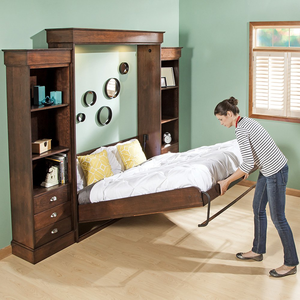Data of Murphy bed
A murphy bed (in North America), in like manner, called a divider bed, pull-down bed, or cover down the bed, is a bed that is turned toward one side to store vertically against the divider, or inside a storeroom or department.
History

In 1900 they applied for his first licenses of the bed is named after William Lawrence (1876-1957). As indicated by legend, he was charming a show artist, yet living in a one-room condo in San Francisco, and the ethical code of the time disapproved of a lady entering a man’s room. Murphy’s development changed over his room into a parlour, empowering him to engage. Prior foldup beds had existed and were even accessible through the Sears, Roebuck, and Co. inventory, yet Murphy presented turn and offset for which he got a progression of licenses, including one for a “Vanishing Bed” on June 18, 1912, and another for a “Structure for a Bed” on June 27, 1916.
Murphy beds are utilized for space-sparing purposes, much like trundle beds, and are famous where floor space is constrained, for example, little houses, condos, lodgings, manufactured homes, and school quarters. As of late, Murphy bed units have included alternatives, for example, lighting, stockpiling cupboards, and office parts. They have seen a resurgence in notoriety in the mid-2010s because of the frail economy, with youngsters moving back in with their folks and families deciding to redesign homes as opposed to buying bigger ones.
Structures and models
Most Murphy beds don’t have box springs. Rather, the sleeping cushion, as a rule, lies on a wood stage or wirework and is held set up so as not to list when in a shut position. The sleeping cushion is connected to the bed outline, frequently with flexible lashes to hold the bedding in position when the unit is collapsed upstanding. Cylinder lifts or twist springs make current Murphy beds simple to lower and raise.
Directions for working for a Murphy bed
Since the principal model, a few different varieties and structures have been made, including sideways-mounted Murphy beds, Murphy lofts, and arrangements that incorporate different capacities. Murphy beds with tables or work areas that overlay down when the bed is collapsed up are well known, and there are likewise models with sofas[citation needed] and racking solutions.[citation needed]
In mainstream society
Murphy beds were a typical arrangement for comic scenes in early film, remembering for quiet movies. The soonest realized film to include a Murphy bed is the lost 1900 Biography Company film A Bulletproof Bed, which was changed in 1903 by Edison Pictures as the surviving film Suburb Surprises the Burglar. It was an intermittent droll component in numerous Keystone Studios creations of the 1910s, including Cursed by His Beauty (1914), Fatty’s Reckless Fling (1915), He Wouldn’t Stay Down (1915), and Bath Tub Perils (1916). Charlie Chaplin’s 1916 One AM likewise includes a misrepresented experience with a Murphy bed.
Later movies which use Murphy beds as comic props (regularly to cause injury or dissatisfaction, or to shroud a furtive visitor) incorporate Laurel and Hardy’s Be Big (1930), Jimmy Stewart and Ginger Rogers’ Vivacious Lady (1938), Buster Keaton’s Spite Marriage (1929) and Nothing But Pleasure (1940), Abbott and Costello’s Hit the Ice (1943), a few Three Stooges shorts (counting 1952’s Corny Casanovas), It’s a Mad, Mad, Mad, Mad World, the Popeye animation Shuteye Popeye, Bob Hope’s Boy, Did I Get a Wrong Number (1966), the James Bond film You Only Live Twice, The Night They Raided Minsky’s, Mel Brooks’ Silent Movie, The Pink Panther Strikes Again, The Great Muppet Caper, Police Academy 2, Who Framed Roger Rabbit, Spy Hard, and Freddy versus Jason. Murphy beds have additionally been utilized in TV arrangement; for instance, Caroline Channing utilized a Murphy bed in 2 Broke Girls and a scene of Laverne and Shirley re-makes scenes from Chaplin’s One A.M. Murphy bed choke. Murphy beds were a standard enough element of the comic film to welcome analysis from retailers; one store situated in Vancouver, British Columbia commented in a notice, “Gone are the times of Laurel and Hardy where the beds were depicted as an overlay away snare for your most exceedingly awful foes.”



